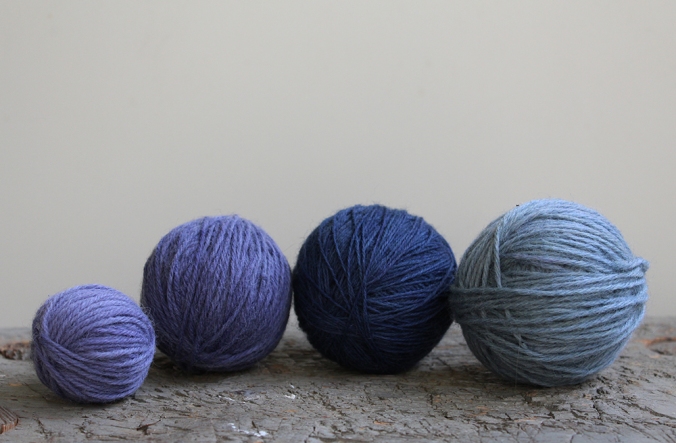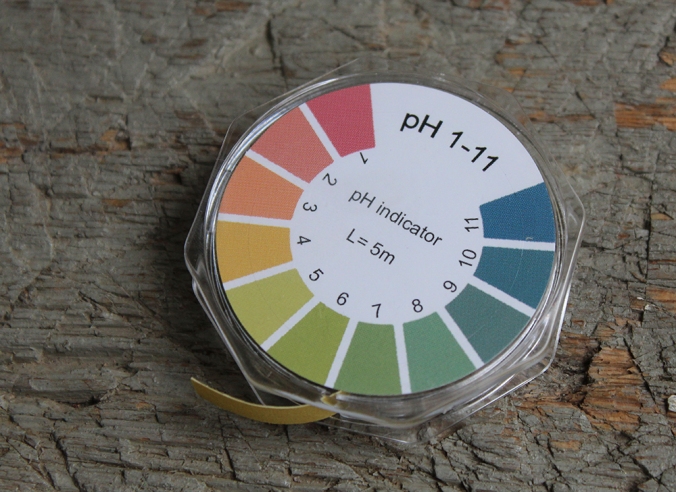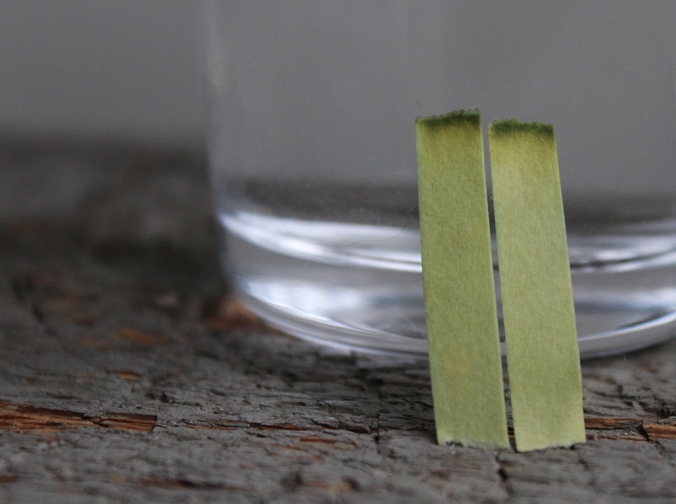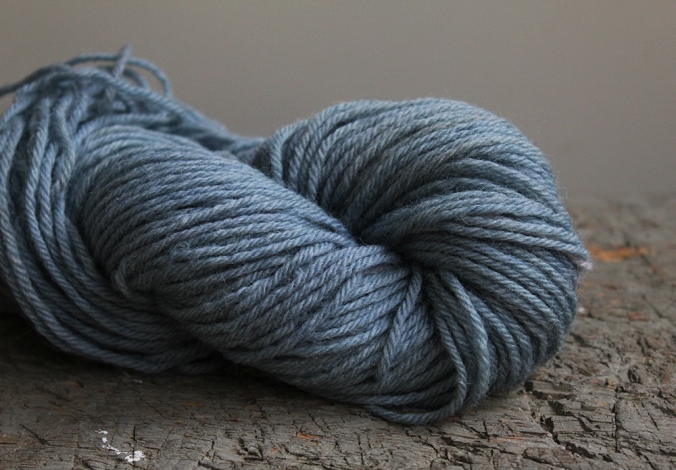You might remember that not so long ago I experimented with dyeing with black beans. My white wool yarns became violet and the grey yarn navy blue (below from left to right). I was a bit puzzled at the time why my yarn didn’t become sky blue as I expect to happen. Well, as you can see on the right, I did it! I changed quite a lot of factors, so I can’t be sure what was it that made the difference in the end.
I bought some pH indicator paper to test our tap water’s pH-level and compere it to the bottled spring waters pH level. My idea was that our tap waters pH would be much lower and that would explain the violet colour. Well, it turned out that both water’s measured identical 6, so there goes my theory. To give some perspective number 7 is the neutral pH level, pH less than 7 are acidic and solutions with a pH greater than 7 are basic or alkaline. The last time I’ve had to think about things like this was at chemistry class in school.
I did test what would happen if I mix some vinegar to the water and that did drop the pH to 4. When I was using the black beans for the first time, I did put some vinegar to the last rinsing water so that might have something to do with the violet colour. Still I swear that the colour was already violet before that.
The other factors I changed were:
The beans. I changed the brand of black beans I used. Although they were both imported from China and the only difference was that the new ones were organic.
The yarn. Both yarns were 100% lambswool, only difference was that the first one was a Finnish yarn (and maybe a bit greasier) and the other yarn was from Peru.
Mordanting. The first time I used only alum as mordant, but the second time I used both alum and the cream of tartar. I got a comment to my post about red cabbage from VerenaErin and she said that alum itself is very acidic. I tested it by mixing some alum to tap water and the pH-level dropped to 4 and after I added some cream of tartar I got 3. But that is just confusing me even more.
The time. The first time around I let the yarn soak in the dye for 24 hours and the second time 48 hours, so twice as long.
No vinegar. First time I did this I noticed that the colour kept on getting off when I was doing the rinsing afterwards. I added a pit of vinegar to the rinsing water which I also think might have highlighted the violet colour.
The last time I also notice that the colour kept on getting off even after the yarn was dry. But this time it was much easier to rinse the yarn and the colour stayed. So which one of the factors listed above is responsible for this? I’m puzzled. But anyhow, I did manage to get the blue I wanted in the end! Even though I have no clue how.




I gotta get more beans soaking for dinner before my next experiment. At least you are getting nice colours.
Interesting to see how you will succeed. 🙂
I love both colors. I always use cream of tartar when I mordant with alum because it’s supposed to help the alum absorb into the fiber. My guess is the vinegar was the reason for the purple? It’s supposed to make fiber yellower. I ofter use washing soda (soda ash) as an alkaline modifier. I wonder how that would change the color? I really need to start experimenting. 🙂
I have started to use cream of tartar now myself for the same reason. You might be right, that the vinegar is the reason, something has to be. 🙂 I haven’t tried washing soda with anything yet, that could be interesting.
I’ve definitely read about vinegar pushing the blue towards the purple end of the spectrum, I used it as an acid modifier to make my blue bluer when I used black beans as I got a slightly greenish blue. I think an alkaline modifier might make it more green? (Based on nothing whatever but a general feeling from what I’ve read)
It would be really interesting to try if I could get more greenish colour by using washing soda, I really liked your turquoise shades. And I guess it really has to be the vinegar that made the yarn purple.
Pingback: Natural Dyeing: Colours from the Supermarket | The Easy Blues
I don’t get any blue shades by dyeing with black beans. I got only very dull grey. I Have tried with different black beans, nevertheless. Wonder what’s wrong?
That’s interesting? Do you use some mordant? I think iron turns things more grey colour. I have also noticed that dyeing with heath does not give blue with black beans (I got light pink). Do you soak your beans for long enough? I soak them for minimum of 12 hours and not with too much water so the dye will be strong.
I tried to dye cotton without the mordant and only achieved different shades of grey. will now try a recycled potash mordant…and experient how this affects colour shading.
Interesting. Some colours really need a mordanted fabric, I quess Black beans are one of those ones. (Sorry for a late reply. I have not been active with this blog)
Pingback: Natural Dyeing: Black Beans, Part 3 | The Easy Blues